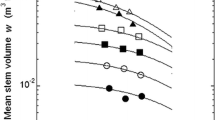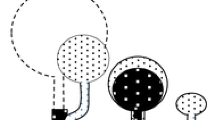The effect of variations in fertility level of the substrate on the self-thinning lines followed by populations of Ocimum basilicum L. was investigated experimentally by establishing populations over a range of densities at two fertility levels. Populations from each fertility level followed different self-thinning lines for shoot biomass. Self-thinning began at a lower biomass in populations grown at the higher fertility level; the subsequent slope of the thinning line was −0.5 for these stands on a log shoot biomass versus log density plot. The slope of the self-thinning line was flatter (−0.29) at the lower fertility level. Fitting the self-thinning line by the Structural Relationship rather than the Major Axis made little difference to line estimates. Biomass packing differed with fertility level, with plants from the higher fertility stands requiring more canopy volume for given shoot biomass than plants from lower fertility levels. Biologically, this would mean shoot competition intensified more rapidly at the higher fertility level as biomass accumulated in stands. The difference in slope between fertility levels was associated with changes above- and belowground. The radial extension of the canopy versus shoot mass relationships of individual plants differed with fertility level. Plants at the lower fertility level allocated more biomass to root growth, and had less leaf area per unit root length. The differences in slope of the self-thinning lines may have been because of differences in the radial extension of the canopy versus shoot mass relationships of individual plants at each fertility level, and/or to an increase in root competition at the lower fertility level.
Similar content being viewed by others
REFERENCES
Bazzaz F. A. & Harper J. L. (1974) Relationship between plant weight and numbers in mixed populations of Sinapsis alba (L.) Rabenh. and Lepidium sativum L. Journal of Applied Ecology 17: 211–216.
Burrows F. M. (1991) Biomass production, structural deformation, self-thinning and thinning mechanisms in monocultures. Philosophical Transactions of the Royal Society of London B 17: 119–145.
Casper B. B. & Jackson R. B. (1997) Plant competition underground. Annual Review of Ecology and Systematics 17: 545–570.
Clutton-Brock T. H., Albon S. D. & Harvey P. H. (1980) Antlers, body size and breeding group size in the Cervidae. Nature 17: 565–567.
Dunn C. P. & Sharitz R. R. (1990) The relationship of light and plant geometry to self-thinning of an aquatic annual herb, Murdannia keisak (Commelinaceae). New Phytologist 17: 559–565.
Firbank L. G. & Watkinson A. R. (1985) A model of interference within plant monocultures. Journal of Theoretical Biology 17: 291–311.
Gardner E. R. (1990) Fertiliztion and thinning effects on a Douglas-fir ecosystem at Shawnigan Lake: A 15-year growth response. Information Report, Forestry Canada, Pacific and Yukon Region, Pacific. Forestry Centre, British Columbia.
Gibson D. J. & Goode R. (1986) Population structure and thinning in natural stands of Atlantic white cedar (Chamaecyparis thyoides (L.) BSP. Oecologia 17: 348–353.
Givnish T. J. (1986) Biomechanical constraints on self-thinning in plant populations. Journal of Theoretical Biology 17: 139–146.
Harvey P. H., Clutton-Brock T. H. & Mace G. M. (1980) Brain size and ecology in small mammals and primates. Proceedings of the National Academy of Science, United States of America 17: 4387–4389.
Harvey P. H. & Mace G. M. (1982) Comparisons between taxa and adaptive trends: Problems of methodology. In: Current Problems in Sociobiology (ed. King’s College Sociobiology Group) pp. 343–361. Cambridge University Press, Cambridge.
Harvey P. H. & Pagel M. D. (1991) The Comparative Method in Evolutionary Biology. Oxford University Press, Oxford.
Lonsdale W. M. & Watkinson A. R. (1983) Plant geometry and self-thinning. Journal of Ecology 17: 285–297.
Mohler C. L., Marks P. L. & Sprugel D. G. (1978) Stand structure and allometry of trees during self-thinning of pure stands. Journal of Ecology 17: 599–614.
Morris E. C. (1995) Self-thinning in Ocimum basilicum grown at three soil fertility levels with and without mycorrhizal inoculum. Procceedings of the Linnean Society of New South Wales 17: 89–107.
Morris E. C. (1996) Effect of localized placement of nutrients on root competition in self-thinning populations. Annals of Botany 17: 353–364.
Morris E. C. (1999) Density-dependent mortality induced by low nutrient status of the substrate. Annals of Botany 17: 95–107.
Morris E. C. & Myerscough P. J. (1985) Self-thinning and competition intensity over a gradient of nutrient availability. Journal of Ecology 17: 903–923.
Morris E. C. & Myerscough P. J. (1991) Effects of nutrient level on thinning and non-thinning crowding in even-aged populations of subterranean clover. Australian Journal of Ecology 17: 469–479.
Norberg R. A. (1988) Theory of growth geometry of plants and self-thinning of plant populations: Geometric similarity, elastic similarity, and different growth models of plant parts. American Naturalist 17: 220–256.
Rayner J. M. V. (1985) Linear relations in biomechanics: The statistics of scaling functions. Journal of Zoology, London, Series A 17: 415–439.
Ricker W. E. (1984) Computation and uses of central trend lines. Canadian Journal of Zoology 17: 1897–1905.
Sackville-Hamilton N. R., Matthew C. & Lemaire G. (1995) In defence of the –3/2 boundary rule: A re-evaluation of self-thinning concepts and status. Annals of Botany 17: 569–577.
Sall J. & Lehamn A. (1996) JMP Start Statistics: a Guide to Statistics and Data Analysis using JMP and JMP IN Software. SAS Institute Inc., Cary, NJ.
Snedecor G. W. & Cochran W. G. (1980) Statistical Methods, 7th edn. The Iowa State University Press, Ames.
Sokal R. R. & Rohlf F. J. (1995) Biometry, 3rd edn. W. H. Freeman, New York.
Watkinson A. (1980) Density-dependence in single-species populations of plants. Journal of Theoretical Biology 17: 345–357.
Weller D. E. (1987a) A re-evaluation of the –3/2 power rule of plant self-thinning. Ecological Monographs 17: 23–43.
Weller D. E. (1987b) Self-thinning exponent correlated with allometric measures of plant geometry. Ecology 17: 813–821.
Westoby M. (1984) The self-thinning rule. Advances in Ecological Research 17: 167–225.
White J. (1981) The allometric interpretation of the self-thinning rule. Journal of Theoretical Biology 17: 475–500.
White J. & Harper J. L. (1970) Correlated changes in plant size and number in plant populations. Journal of Ecology 17: 467–485.
Yoda K., Kira T., Ogawa H. & Hozumi K. (1963) Self-thinning in overcrowded pure stands under cultivated and natural conditions. Journal of Biology, Osaka City University 17: 107–129.
Author information
Authors and Affiliations
Corresponding author
About this article
Cite this article
Morris, E. Self-thinning lines differ with fertility level. Ecol Res 17, 17–28 (2002). https://doi.org/10.1046/j.1440-1703.2002.00459.x
Received:
Accepted:
Issue Date:
DOI: https://doi.org/10.1046/j.1440-1703.2002.00459.x




